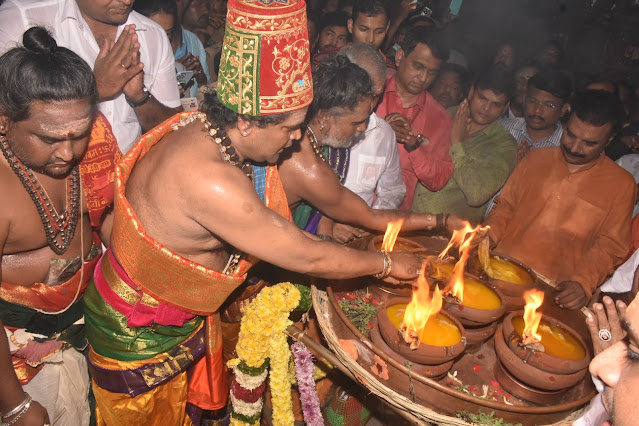18 July 2023
Aani Pramotsavam Theerthavari: Ayyankulam Tank July 17, 2023
Below is a very nice selection of photos of the Aani Pramotsavam Theerthavari function conducted at the Ayyankulam Tank on Monday, July 17, 2023.
7 December 2022
Deepam 2022: Day 10 — Tuesday 6 December
Bharani Deepam early morning December 6, 2022
Mahadeepam, Dusk December 6, 2022: Temple
Mahadeepam, Dusk December 6, 2022: Arunachala Summit
Temple Lights from Arunachala Summit
16 April 2022
Chitra Pournami 2022: Early morning crowds
The largest Arunachala girivalam crowds are experienced at the time of Karthigai Mahadeepam. However after that—the second most attended girivalam is held to be that performed at the time of Chithirai Pournami.
This year Tiruvannamalai District is set to witness up to 2 million devotees for the occasion of Chithirai Pournami. The three photographs posted below are of the early build-up of devotees here to observe this significant occasion.
Devotees near Alankaram Mandapam, in front of East Gate of Temple. Arunachala in background.
Early morning crowds milling around on Car Street
 |
| Devotees on the streets of Tiruvannamalai for the occasion of 2022 Chitra Pournami |
18 March 2022
Arunachala Girivalam: 2022 Paguni Month Full Moon
The below photographs are of devotees performing Arunachala Girivialam during this 2022 Paguni month Full Moon. It is welcoming to view the beginning of the inflow of devotees returning to Arunachala.
1 March 2022
Happy Mahashivaratri 2022
To understand the significance of Mahashivaratri visit an earlier posting at this link here which gives an indepth explanation of the legends associated with this great Festival.
15 January 2022
Pongal Festival 2022: Tiruvannamalai and Arunachaleswarar Temple
Uttarayana Brahmotsavam festival Flag Hoisting
This time known as Uttarayana marks the Sun's movement in the skies. The periods of Uttarayana and Dakshinayana are each comprised of six months. Uttarayana means the northern movement of the sun. The period starting from Capricorn Zodiac (Makara Rashi) up to Gemini Zodiac (Mithuna Raasi) is Uttarayana. The period when Sun leaves Gemini Zodiac is known as Kataka Sankramana and this marks the end of the Uttarayana period. This happens annually on July 15th or 16th.
In terms of sadhana: Dakshinayana is for purification and Uttarayana is for enlightenment. The first half of Uttarayana (until the equinox in March) is particularly believed to be a period when a maximum amount of grace is available. This is a time of receptivity, grace and enlightenment and of the attainment of the ultimate. It is the time to harvest and is the reason agricultural harvests begin during this period.
An important part of the celebration of this change of the Sun's movement in the skies is the festival of Pongal which follows Uttarayana Brahmotsavam.
Pongal is not only a festival for crops and food grains but also an auspicious opportunity to harvest human potential.
Although originally Pongal was a Festival for the farming community—nowadays it is celebrated by all. It follows the solar calendar and each function occurs on the same day each year.
At Tiruvannamalai (and throughout Tamil Nadu) the four consecutive days of Pongal are:-
'Bhogi' January 13th
'Pongal' January 14th
'Mattupongal' January 15th, and
'Thiruvalluvar Day' on Jan 16
The below photographs taken on Mattupongal January 15, are of the lavishly decorated Lord Nandi at Arunachaleswarar Temple.
For full information
about the day of Mattupongal, visit an earlier posting at this link here.
1 January 2022
Arunachaleswarar Temple Pradosham: Friday December 31, 2021
The photographs below are of the last Pradosham of 2021. This Shukra Pradosham occurred on Friday, December 31 and its particularly cheering to see the pradosham attended by so many devotees.
27 December 2021
Arudra Darshan Lord Nataraja Abhishekam and Deeparathani: December 20, 2021
Below are photographs of the abhishekam and deeparathani performed on Lord Nataraja and the Goddess at the Arunachaleswarar Temple, 1000 Pillar Hall on Wednesday, January 11, 2017. Arudra Darshan is observed in the Tamil month of Margazhi (December–January). It takes place at the time of the full moon (along with Arudra Birth Star) and is the longest night of the year.
This function celebrates the cosmic dance of Lord Shiva, which is represented by the Nataraja form. The term 'Nataraj' means 'King of Dancers' (nata = dance; raja = king). Arudra denotes a red flame and Lord Siva has also a name called "Semporjyoti" or "Golden Red Flame," and thus Nataraja is the manifestation of Siva as a Light.
The cosmic dance of Lord Shiva represents five activities–Creation, Protection, Destruction, Embodiment and Release–thereby representing the continuous cycle of creation and destruction. It is believed that the energy from this dance of bliss (Ananda Tandavam) sustains the cosmos, and when Siva is finished with this dance, the Universe will end and a new one will begin.
This Festival is in particular celebrated in a grand manner in the five Sabhas of Sri Nataraja. Lord Shiva as Nataraja (Lord of the Dance) performs the Tandava–the dance in which the Universe is created, maintained, and resolved. The five places where Lord Nataraja performed His Tandavam are collectively known as Pancha Sabhas meaning Five Assembly Halls of Lord Nataraja.
(1) Kanakasabha (Gold) at Chidambaram, Ananda Tandavam (Dance)
(2) Velli Sabhai (Silver) at Madurai, Sandhya Tandavam (Dance)
(3) Ratnasabha (Ruby) at Tiruvalankadu , Oordhva Tandavam (Dance)
(4) Tamrasabha (Copper) at Tirunelveli, Muni Tandavam (Dance)
(5) Chitrasabha at Kutralam, Tripura Tandavam (Dance)
In this festival at Arunachaleswarar Temple, Abhishekam of Lord Nataraja takes place early in the morning and He and the Goddess then come outside amongst devotees. Only a few times a year is the statue of Lord Nataraja brought out of its permanent home at the 2nd Prakaram of Arunachaleswarar Temple.
For more information and photographs about the performance of this Festival at Arunachaleswarar Temple, please visit an earlier post at this link here.
























































